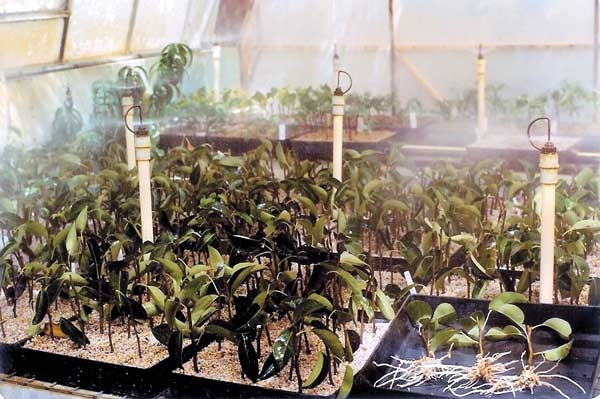“An experiment at the Tatura Research Institute has shown that pear trees propagated on their own roots can match the productivity of trees on a rootstock.”
While the search goes on unabated for the elusive size-controlling precocious pear rootstock, an experiment at the Tatura Research Institute has shown that pear trees propagated on their own roots can match the productivity of trees on a rootstock.
Cutting the cost of trees
The cost of trees is often more than half the total cost of establishing a Tatura Trellis planting.
The experiment at Tatura showed that pear trees can be propagated cheaply from softwood cuttings, and made productive at an early age.
The aim was to substantially reduce the cost of trees and so increase interest in the Tatura system of growing pears.
Propagating and planting out
Leafy (softwood) cuttings of Packham’s Triumph taken in December, treated with a root-promoting hormone, and placed under a mist propagation unit, produced roots within 60 days.
The cuttings were then potted up, and in August they were planted on Tatura Trellis as dormant rooted cuttings 1.0 m apart and in rows 4.5 m wide (2222 trees per hectare).
Each tree developed a leader to the left and to the right. Branches were trained at about 30 degrees to horizontal and tied to the trellis wires with small plastic ties. Initial training and pruning were done in spring and summer.
A dormant rooted cutting of Winter Nelis was planted as polliniser at each trellis frame (15 m apart). Trees were irrigated with microjets.
The decade–long trial
Adjacent to the Packham experiment was the first Tatura Trellis with Williams’ Bon Chretien on Pyrus calleryana D6 seedling rootstock planted at the same tree and row spacing.
Packhams were grown for the fresh market and Williams for the cannery. Packham yields were compared with those of Williams for 10 years.
Tree costs plummet
The cost of raising a self-rooted tree was estimated to be less than one-eighth the cost of raising a tree with a rootstock.
Fruit quality maintained
Australian Export Pear Standards were followed when fruit quality and fruit size of Packhams were assessed.
An average assessment for the last six years is as follows: •unblemished fruit fit for export 67% (ranged from 59% to 79%) •limbrub 8% •sunburn 4% •misshapen 8% •russet 6% •undersize (less than 57 mm diameter) 7%.
Williams yields are shown in Table 1 as canning-grade (larger than 57 mm diameter). See Tree Fruit Dec 2011
Own roots vs others
Well-managed productive orchards of Packhams on Tatura Trellis in Australia (on P. calleryana D6) and South Africa (on BP1 and BP3) produced between 72 and 81 tonnes per hectare annually.
Yields in Table 1 (See Tree Fruit Dec 2011) are equal or better than those obtained from overseas reports of yields of different pear varieties on Old Home x Farmingdale (OHxF) and quince rootstocks at approximately the same tree density.
Too radical for nurseries?
Propagating pear trees on their own roots has not been adopted by nurseries in Australia. Perhaps it is too radical.
Perhaps the logic and persuasion were not convincing enough for a traditional nursery industry dealing with fruit trees.
With the ever-increasing cost of nursery trees and an emphasis on high density planting, ‘thinking outside the box’ can have boundless possibilities.
To see the photos & tables with this article goto the December 2011 Tree Fruit






















